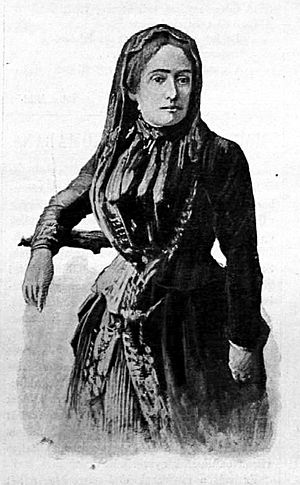Zsófia Torma facts for kids
Quick facts for kids
Zsófia Torma
|
|
|---|---|

Newspaper portrait of Torma
|
|
| Born | 26 September 1832 Csicsókeresztúr, Austria-Hungary
|
| Died | 14 November 1899 (aged 67) Szászváros (present-day Orăştie), Hungary
|
| Nationality | Hungarian |
| Occupation | Archaeologist, anthropologist and paleontologist |
Zsófia Torma (born September 26, 1832 – died November 14, 1899) was an amazing Hungarian scientist. She was an archaeologist, an anthropologist, and a paleontologist. This means she studied ancient human history, cultures, and fossils.
Contents
Early Life and Discoveries
Zsófia Torma was born in a place called Csicsókeresztúr. This was in Austria-Hungary, which is now part of Romania. After her parents passed away, she moved with her sister to Szászváros.
Starting Her Own Research
In Szászváros, Zsófia began to study old snail farms. She found these farms in Hunedoara County. She mostly taught herself everything she knew.
In 1875, a famous Hungarian archaeologist named Flóris Rómer encouraged her. He told her to start her own digs. Zsófia then began to excavate an ancient settlement. This place was called Tordos, located along the Mureş River.
Amazing Finds at Tordos
During her excavations, Zsófia found many clay objects. These objects had strange symbols and scripts on them. Her discoveries became a big deal in archaeology.
She also found items from the 6,000 to 7,000-year-old Tordos culture. Some of these items had special Vinca symbols. Zsófia was the first to find this ancient culture. She showed how the Tordos symbols might be linked to very old writings from Assyria and Babylon. She even thought they might be connected to Sumerian literature.
Zsófia worked at Tordos for 20 years. Her careful work and valuable finds were very important. The Vinca-Tordos culture was not fully explored until 1908. This was more than 30 years after Zsófia's first discoveries.
Challenges and Recognition
Zsófia Torma faced many difficulties. She paid for her excavations herself, which caused money problems. She also struggled with other archaeologists in her own country.
Facing Disbelief
Many people in Hungary made fun of her. They ignored her because she was a woman. They also saw her as an amateur, not a professional. Her new ideas were often not taken seriously.
However, researchers from other countries respected her work. They wrote many letters to her. They accepted her amazing finds and writings.
Famous Work and Legacy
Her most famous book was called Ethnographische Analogien. It was published in Jena, Germany, in 1894.
Zsófia also played a key role in starting a museum. This was the National Museum of Transylvanian History in Kolozsvár. Today, this city is known as Cluj-Napoca. In her will, she left her huge collection to the museum. This collection included 10,387 archaeological pieces.
Just a few months before she died, Zsófia received a great honor. On May 24, 1899, she became the first woman to be named an honorary doctor. This was at the Kolozsvári m. kir. Ferencz József Tudomány. Today, this is known as Babeș-Bolyai University.
Zsófia Torma passed away in Szászváros on November 14, 1899. Today, this town is called Orăştie.
Images for kids
See also
 In Spanish: Zsófia Torma para niños
In Spanish: Zsófia Torma para niños


